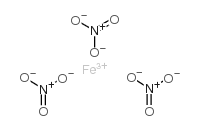| 结构式 | 名称/CAS号 | 全部文献 |
|---|---|---|
 |
硝酸铁(九水)
CAS:7782-61-8 |
|
 |
硝酸铁
CAS:10421-48-4 |
| 结构式 | 名称/CAS号 | 全部文献 |
|---|---|---|
 |
硝酸铁(九水)
CAS:7782-61-8 |
|
 |
硝酸铁
CAS:10421-48-4 |